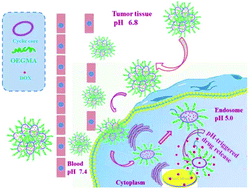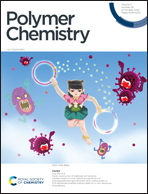Facile construction of stabilized, pH-sensitive micelles based on cyclic statistical copolymers of poly(oligo(ethylene glycol)methyl ether methacrylate-st-N,N-dimethylaminoethyl methacrylate) for in vitro anticancer drug delivery†
Abstract
Cyclic polymers have outperformed their linear analogues for controlled release applications in terms of greater stability and better therapeutic efficiency due to the endless chain topology. However, to our knowledge, there have been thus far only a few examples of the fabrication of pH-sensitive cyclic polymers for drug delivery applications. To further improve the colloidal stability of the previously synthesized cyclic poly(N,N-dimethylaminoethyl methacrylate) (PDMAEMA) for drug delivery applications via a facile yet efficient approach, it will be useful and straightforward to incorporate a hydrophilic monomer for copolymerization with DMAEMA. For this purpose, we reported in this study the preparation of pH-sensitive cyclic statistical copolymers, P(OEGMA-st-DMAEMA)s, with two different compositions by atom transfer radical polymerization (ATRP) of oligo(ethylene glycol) monomethyl ether methacrylate (OEGMA) and DMAEMA and subsequent “intra-chain” click cyclization of the α-alkyne-ω-azide linear precursor. A further comparison study on the micelle stability revealed that the spherical micelles self-assembled from c-P(OEGMA4-st-DMAEMA38) (C) with both smaller hydrodynamic size than that of the micelles of the linear analogue, l-P(OEGMA4-st-DMAEMA38) (L), and greater salt stability than that of the micelles of c-P(OEGMA8-st-DMAEMA38) were screened to be the optimal micelle construct for drug delivery applications. Flow cytometry (FCM) analysis confirmed greater cellular uptake efficiency of doxorubicin (DOX)-loaded C (C@DOX) micelles than that of the L (L@DOX) ones. More importantly, the C@DOX micelles showed comparable in vitro cytotoxicity against the cancer cell line (HeLa cells) but lower in vitro cytotoxicity against the normal cell line (HUVEC cells) relative to the L@DOX formulation after 72 h of incubation. Therefore, this study not only developed a facile approach to improve the colloidal stability of a cyclic polycation, but also presented a pH-sensitive cyclic copolymer-based nanoplatform with great potential for anticancer drug delivery.



 Please wait while we load your content...
Please wait while we load your content...